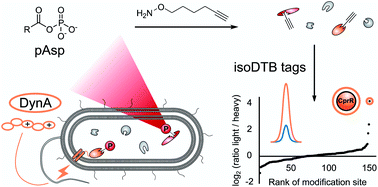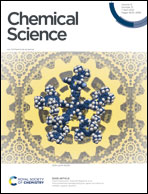A tailored phosphoaspartate probe unravels CprR as a response regulator in Pseudomonas aeruginosa interkingdom signaling†
Abstract
Pseudomonas aeruginosa is a difficult-to-treat Gram-negative bacterial pathogen causing life-threatening infections. Adaptive resistance (AR) to cationic peptide antibiotics such as polymyxin B impairs the therapeutic success. This self-protection is mediated by two component systems (TCSs) consisting of a membrane-bound histidine kinase and an intracellular response regulator (RR). As phosphorylation of the key RR aspartate residue is transient during signaling and hydrolytically unstable, the study of these systems is challenging. Here, we apply a tailored reverse polarity chemical proteomic strategy to capture this transient modification and read-out RR phosphorylation in complex proteomes using a nucleophilic probe. In-depth mechanistic insights into an ideal trapping strategy were performed with a recombinant RR demonstrating the importance of fine-tuned acidic pH values to facilitate the attack on the aspartate carbonyl C-atom and prevent unproductive hydrolysis. Analysis of Bacillus subtilis and P. aeruginosa proteomes revealed the detection of multiple annotated phosphoaspartate (pAsp) sites of known RRs in addition to many new potential pAsp sites. With this validated strategy we dissected the signaling of dynorphin A, a human peptide stress hormone, which is sensed by P. aeruginosa to prepare AR. Intriguingly, our methodology identified CprR as an unprecedented RR in dynorphin A interkingdom signaling.



 Please wait while we load your content...
Please wait while we load your content...